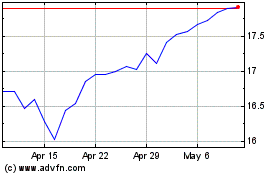PG&E's collapse shows the warming planet is ever-more
capable of delivering sudden shocks to the balance sheet
By Russell Gold
This article is being republished as part of our daily
reproduction of WSJ.com articles that also appeared in the U.S.
print edition of The Wall Street Journal (January 19, 2019).
PG&E Corp.'s bankruptcy could mark a business milestone: the
first major corporate casualty of climate change. Few people expect
it will be the last.
California's largest utility was overwhelmed by rapid climatic
changes as a prolonged drought dried out much of the state and
decimated forests, dramatically increasing the risk of fire. On
Monday, PG&E said it planned to file for Chapter 11 protection
by month's end, citing an estimated $30 billion in liabilities and
750 lawsuits from wildfires potentially caused by its power
lines.
The company's fall has been fast and steep. In October, its
market value was $25 billion. This week, it was removed from the
S&P 500 as its value tumbled below $4 billion and its shares
fell to their lowest level since at least 1972.
The PG&E bankruptcy could be a wake-up call for
corporations, forcing them to expand how they think about
climate-related risks, management consultants and other experts
said.
Previously, companies mainly worried over risks from new
governmental regulations related to climate change, said Christophe
Brognaux, a managing director at Boston Consulting Group. The
PG&E case makes clear that companies also have to worry about
sudden, and potentially unexpected, impacts to their core assets
and liabilities, he added.
"Physical risks have only recently manifested themselves. This
is a fairly new development," said Bruce Usher, a professor at
Columbia University's business school who teaches a course on
climate and finance. "If you are not already considering extreme
weather and other climatic events as one of many risk factors
affecting business today, you are not doing your job."
J. Bennett Johnston, a former Democratic U.S. senator from
Louisiana who has served on Chevron Corp.'s board of directors,
said the potential for climate change to damage company assets and
cause a mushrooming of liabilities is an emerging enterprise
risk.
"The business community, by and large, has gotten the message,"
he said. "You have to be pretty stupid not to see we're in the
midst of a climate crisis and it's getting worse."
Climate wasn't the only factor that is pushing PG&E to a
likely bankruptcy. State regulations also played a role. PG&E
is required to provide electrical service to the thousands of
people moving annually in the state's forested areas. Moreover, an
unusual California state law, known as "inverse condemnation," made
PG&E liable if its equipment started a fire, regardless of
whether it was negligent.
PG&E capital spending plans are overseen by state
regulators, who pressed the company to spend more on tree trimming
but not, until a few months ago, on other fire-prevention measures
such as early-warning weather stations and insulated wires.
PG&E's former chief executive, Geisha Williams, told an
investor conference in January 2018 that policies such as inverse
condemnation could undermine the financial health of utilities and
make them unable to carry out aggressive efforts to combat carbon
emissions. "This policy isn't affordable, and it isn't sustainable.
Ultimately, it carries grave implications for the industry's
financial health and our ability to attract the investment the
state needs to fulfill its climate goals," she said.
PG&E announced on Jan. 13 that Ms. Williams was stepping
down as CEO as the political and financial fallout from the
wildfires continued to grow.
In less than a decade, PG&E, which serves 16 million
customers, saw the risk of catastrophic wildfires multiply greatly
in its vast service area, which stretches from the Oregon border
south to Bakersfield. Weather patterns that had been typical for
Southern California -- such as the hot, dry Santa Ana winds that
sweep across the region in autumn, stoking fires -- were now
appearing hundreds of miles to the north.
"The Santa Ana fire condition is now a Northern California fire
reality, " said Ken Pimlott, who retired last month as director of
the California Department of Forestry and Fire Protection, or Cal
Fire. "In a perfect world, we would like to see all [of PG&E's]
equipment upgraded, all of the vegetation removed from their lines.
But I don't know anybody overnight who is going to catch up."
PG&E scrambled to reduce fire risks by shoring up power
lines and trimming millions of trees. But the company's equipment
kept setting fires -- about 1,550 between mid-2014 through 2017, or
more than one a day, according to data it filed with the state.
PG&E has long accepted the science of climate change. It is
one of several California utilities that, with prodding from state
politicians, has been rapidly shifting to a cleaner energy future.
It had $34.5 billion in long-term renewable energy contracts,
according to a federal filing.
"Here was PG&E, the most 'woke' of utilities in terms of
climate change, " said John Geesman, a former executive director
and then member of the California Energy Commission. "Shouldn't
they have been adapting to climate change more rapidly than
others?"
Other California utilities, such as Sempra Energy's San Diego
Gas & Electric, began investing years ago in technology to shut
off certain power lines during high fire-risk periods as well as
changing the layout of their wires to lower the chance of
inadvertently sparking fires during wind storms.
Extreme weather has led to a few bankruptcies in the past. In
2005, Entergy Inc. placed its New Orleans unit into bankruptcy
after a liquidity crisis caused by the flooding that followed
Hurricane Katrina. That was a much smaller utility and the flooding
was a largely man-made problem of neglected levees and other
infrastructure designed to protect the city.
Other companies have been severely impacted by climate
regulations. The market value of German utilities E.ON SE and RWE
AG plummeted in the early part of this decade as heavy government
subsidies for renewable energy undermined their business models.
More recently, General Electric Co. miscalculated how a global
renewable energy push would reduce demand for giant natural-gas
turbines, one of the many woes that have battered the
conglomerate.
The global business community is recognizing the risks it faces
from climate change. This week, a World Economic Forum survey of
global business and thought leaders found extreme weather and other
climate-related issues as top risks both by likelihood and
impact.
Companies and their risk officers should be more aware that
climate change could lead to unexpected and rapid changes, said
Paula DiPerna, a senior advisor to CDP, an international nonprofit
organization that presses companies to disclose their environmental
impact.
"There is a general sense among policy makers, the general
public and corporations that climate change is going to happen
slowly," she said. "On the contrary, climate change is an extremely
unpredictable series of events. And in the face of that, companies
should be very prepared."
-- Jim Carlton and Rebecca Smith contributed to this
article.
Write to Russell Gold at russell.gold@wsj.com
(END) Dow Jones Newswires
January 19, 2019 02:47 ET (07:47 GMT)
Copyright (c) 2019 Dow Jones & Company, Inc.
PG&E (NYSE:PCG)
Historical Stock Chart
From Mar 2024 to Apr 2024

PG&E (NYSE:PCG)
Historical Stock Chart
From Apr 2023 to Apr 2024
